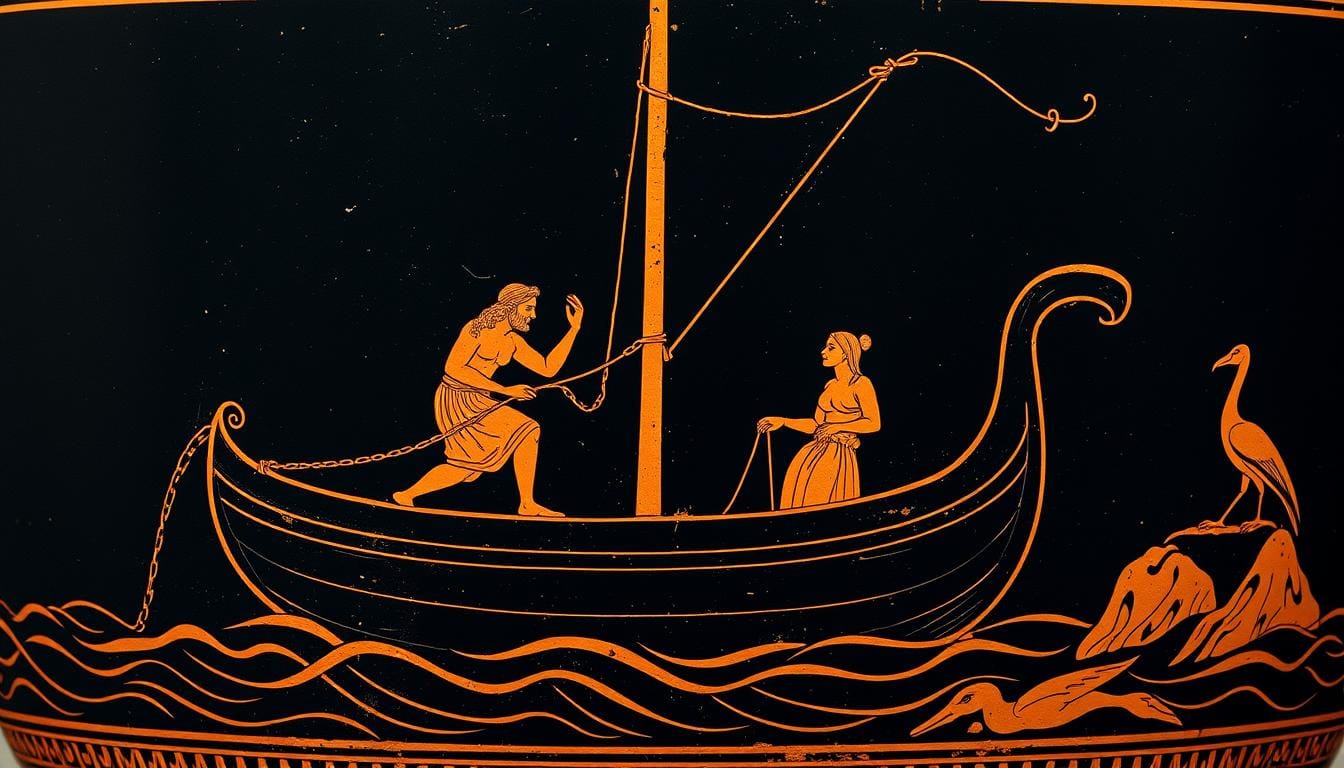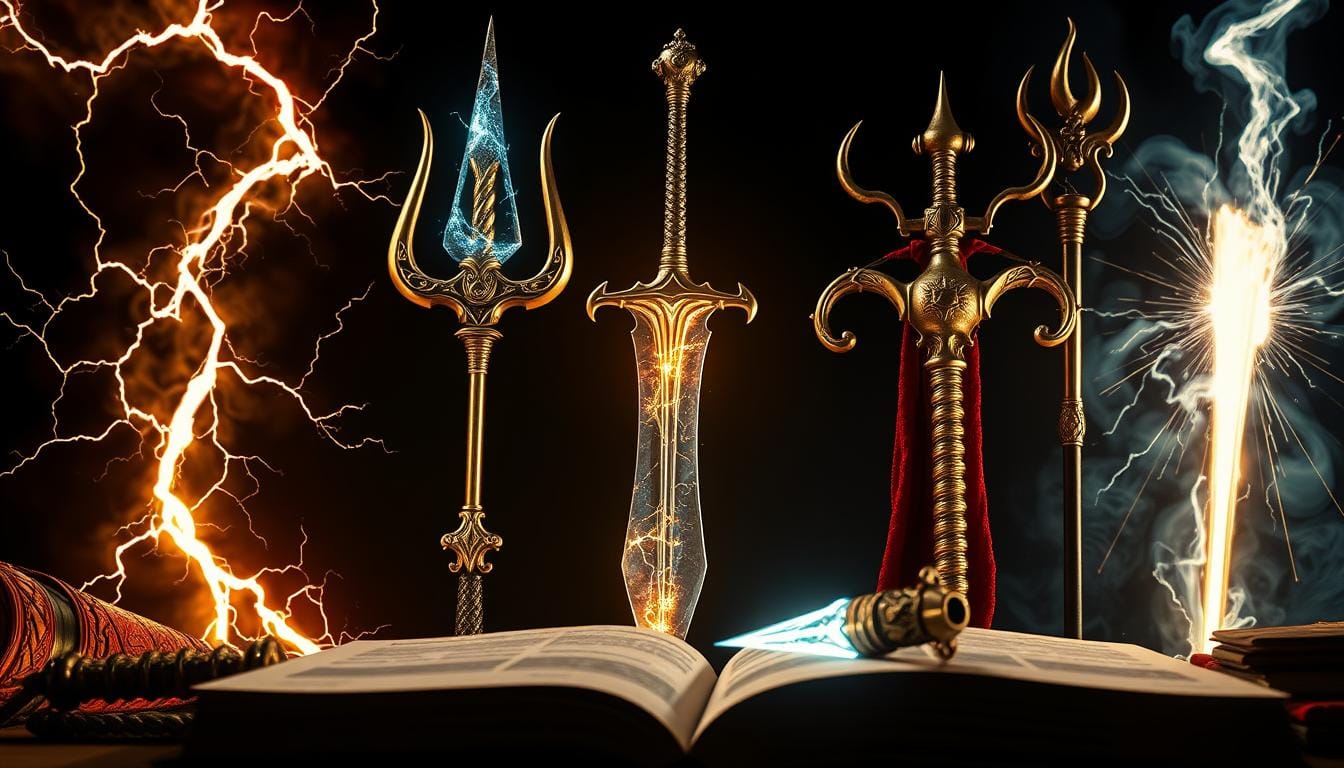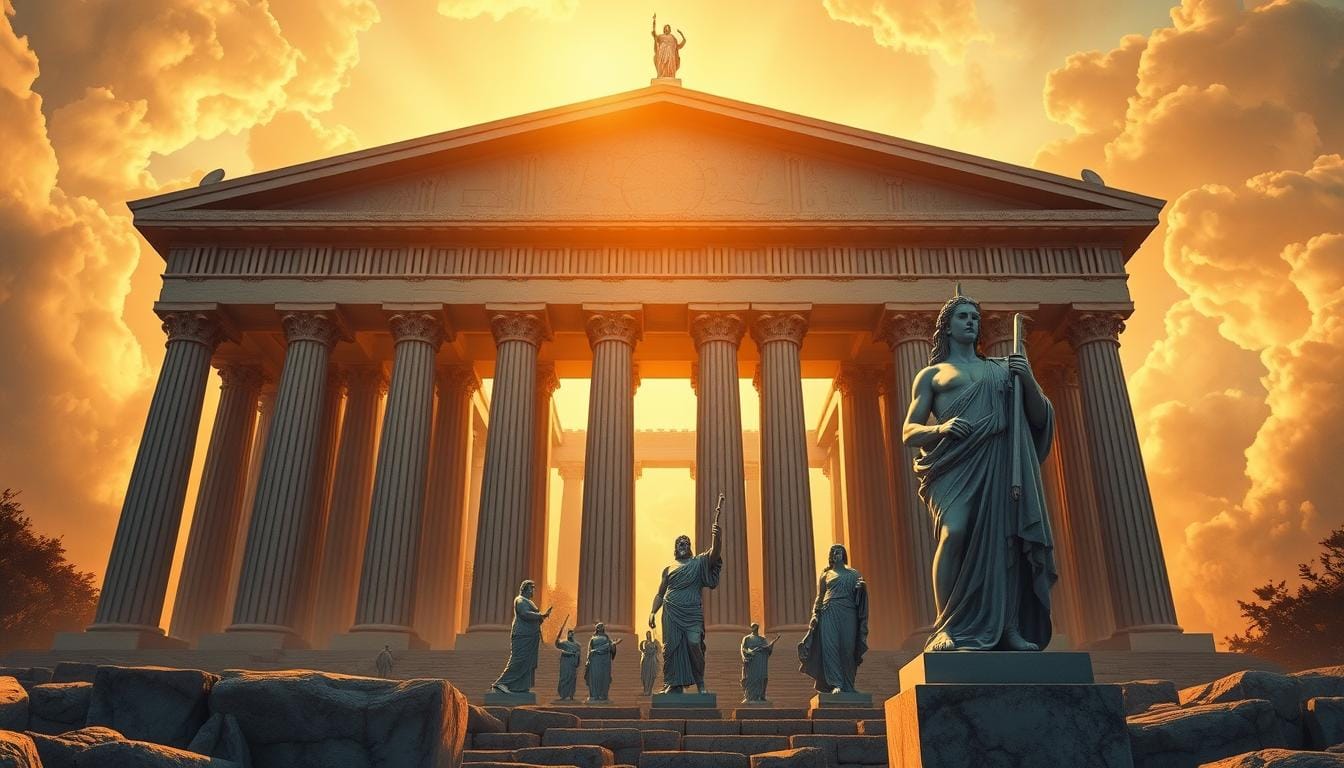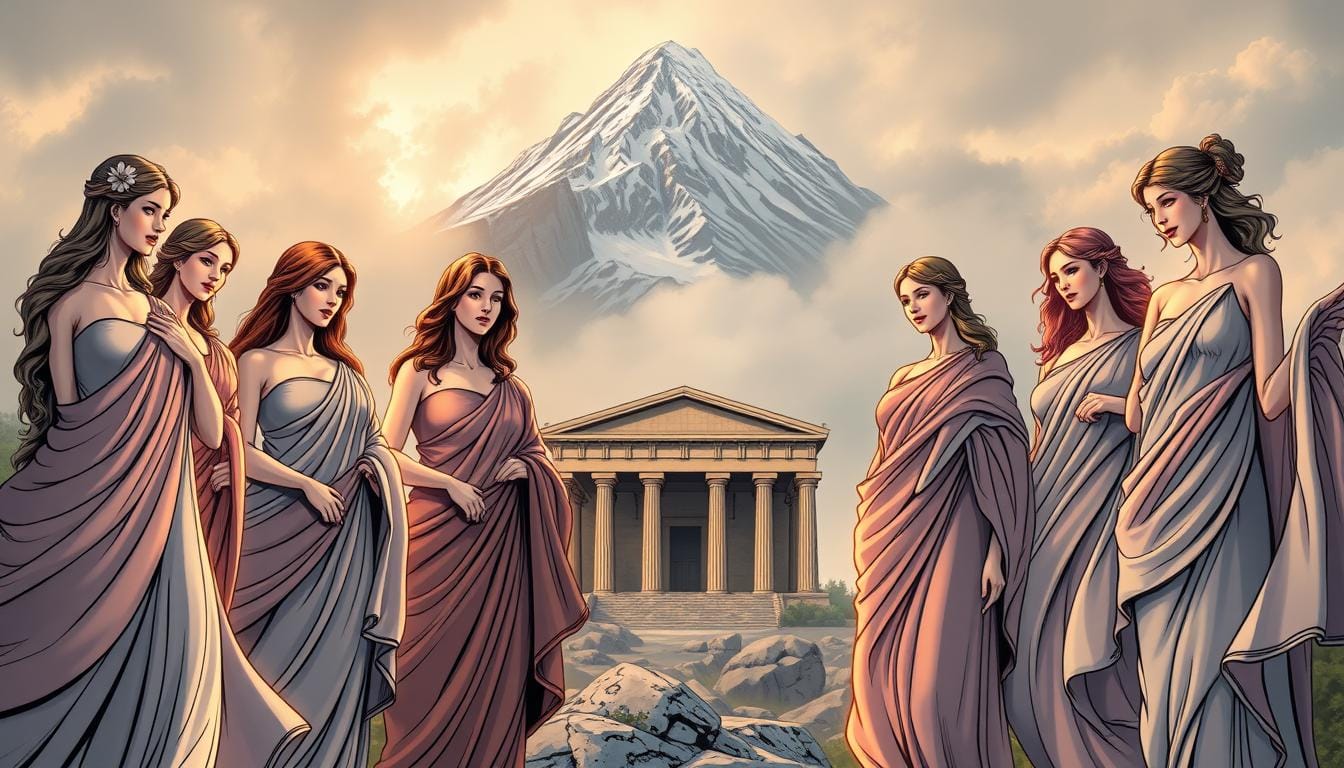For over 2,500 years, Hecate has been a key figure in spiritual practices. Hecate fascinates millions, from those studying Greek myths to modern witches.
This enigmatic goddess was revered for her power. She watched over crossroads, moonlit nights, and the border between life and death. The ancient Greeks saw her as a strong protector, able to move between the worlds of the living and the dead.
Her triple-formed nature allowed her to see past, present, and future at once. Symbols like torches, keys, and dogs showed her roles as a guide and guardian. These symbols have kept her magic and ghostly connections alive for centuries.
Learning about Hecate opens up a world of history and spiritual practices. Her impact has lasted for millennia, making her a must-know for anyone interested in ancient or modern magic.
Key Takeaways
- Hecate originated in ancient Greek religion as a powerful crossroads deity who controlled magic, witchcraft, and lunar cycles
- She possessed unique abilities to move between the realms of the living and the dead, making her a chthonic goddess
- Her triple-formed appearance symbolised her capacity to observe all directions and time periods simultaneously
- Sacred symbols including torches, keys, and dogs represented her roles as guide, boundary keeper, and protector
- Modern spiritual practitioners continue to honour her legacy, demonstrating her lasting influence across cultures
- Her complex nature encompasses both protective and supernatural aspects, making her accessible yet mysterious
Introduction to Hecate and Her Significance
In ancient Greece, Hecate stood out as a divine figure. She was known for magic, protection, and understanding life and death. This deity was respected by all, from common people to gods. Her role went beyond just witchcraft, covering protection, guidance, and being a bridge between worlds.
Hecate’s power was unique. She watched over crossroads, thresholds, and places where the real world met the unknown. The ancient Greeks saw her as a triple goddess, with the qualities of maiden, mother, and crone all at once.
Her presence was felt in everyday life. Homes had shrines for her, and travelers sought her help at crossroads across the Mediterranean.
Overview of Hecate's Origins
There’s debate about where Hecate came from. Some say she was from Thrace, near Bulgaria, or Caria in Asia Minor. Her origins from outside Greece explain her special place in the Greek world.
She arrived in Greece during the Archaic period, after Homer’s epics. Her absence in Homer’s works shows she wasn’t part of the earliest Greek beliefs. Instead, she shows the impact of cultural exchange in the ancient world.
Hecate first showed up in Greek literature in Hesiod’s Theogony in the 7th century BCE. Hesiod’s work set the stage for her worship for centuries to come.
Hecate in Ancient Greek Religion
Zeus himself gave Hecate great respect, calling her “above all” other gods. This made her very powerful, ruling over earth, sea, and sky. Her status was very high in Greek religion.
Her worship was different from other gods. People honored her in homes and at crossroads, not in big temples. This made her close to everyday life. Families and individuals sought her help and guidance.
Places like Caria, Eleusis, and Samothrace were her main worship sites. These places drew people from all over for witchcraft and magical knowledge. The Eleusinian Mysteries, for example, featured her as a key figure.
Her worship varied by region, meeting local needs and traditions. Coastal areas focused on her sea protection, while rural areas valued her for agriculture. This flexibility made her widely accepted in Greece and beyond.
The Symbolism of Hecate
Hecate is a goddess with deep occult and supernatural meaning. Ancient people saw her as a symbol of spiritual power. Her images carry secrets and wisdom that are important today.
Her symbols connect the physical and spiritual worlds. Each part of her image has its own meaning. This helped people understand her complex nature.
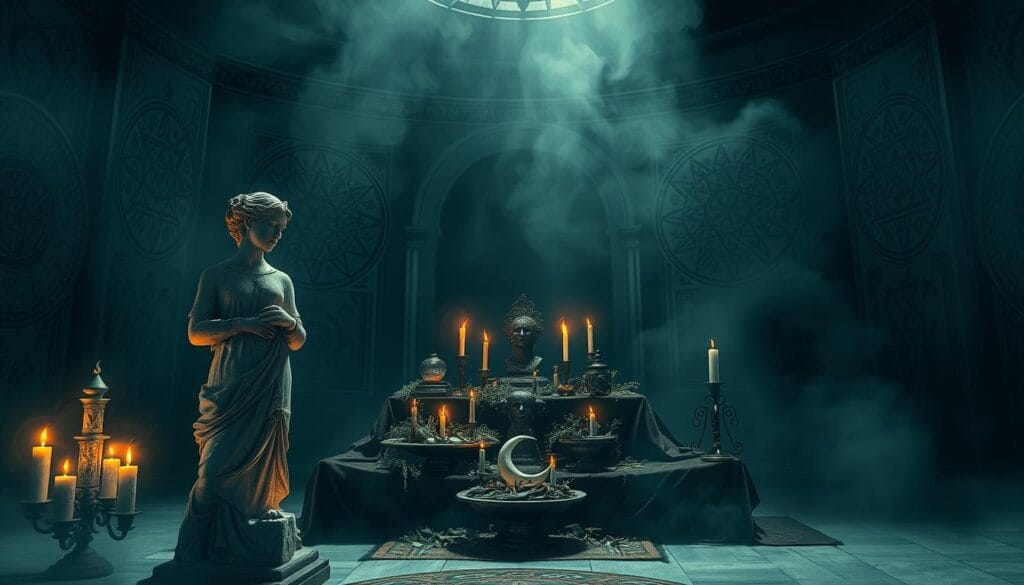
Lunar Connections and Night's Domain
Hecate is linked to the moon in Greek mythology. The night is her sacred place, between day and night. This makes her a goddess of change.
The moon’s phases show Hecate’s power to guide souls. Her supernatural strength is greatest during the new moon. This is when magic is most powerful.
Night is more than just dark to Hecate. It’s the unknown, mysterious, and transformative. She guides those seeking wisdom beyond the usual.
Evolution of the Triple Form
The triple goddess form of Hecate started with sculptor Alcamenes in the 5th century BCE. It shows her seeing past, present, and future. This changed how people saw divine knowledge.
Later, this form became a single goddess with three heads. Each head has its own meaning: dog for loyalty, snake for wisdom, and horse for strength and journey. This change shows how beliefs and art evolved.
The triple form also means Hecate rules earth, sea, and sky. This makes her a universal goddess. Her three sides offer different ways to connect with her, for protection, wisdom, or guidance.
Today, Wiccan traditions use the triple goddess idea. They see it as the maiden-mother-crone archetype. This shows how Hecate’s symbolism has inspired spiritual practices for centuries.
Each part of her triple nature has its role. She can see all directions, making her a perfect guardian of crossroads. Her comprehensive awareness makes her a goddess who misses nothing and protects everything.
Hecate's Role in Magic and Witchcraft
The ancient world saw Hecate as the top goddess of magic and mystical knowledge. Her influence went beyond just worship. She became the primary divine teacher of magical practices. By the 1st century CE, she was known as a guide and protector in spellcraft across the Mediterranean.
People back then didn’t see magic as evil. They saw it as a natural force needing proper guidance. Hecate was there to help, guiding those who wanted to use mystical powers.
Ancient Teachings and Divine Instruction
Hecate was the original teacher of magical arts, history shows. She taught Circe, who then taught Medea. This created a strong tradition in ancient Greek mysticism.
She was known for her knowledge in herbal magic and potion-making. Her understanding of plants helped those using natural remedies and charms. Her underworld ties gave her access to knowledge others didn’t have.
People saw Hecate as a teacher and a protector against bad magic. She could give magical powers and protect from harm. This made her very important for those balancing their magic.
Contemporary Magical Traditions
Today, Hecate is very popular in modern Paganism and Witchcraft. Wiccan practitioners love her for her triple goddess aspects and lunar connections.
Modern magic users call on Hecate for protection and guidance. Her link to crossroads is key for those making big life choices or seeking spiritual change.
Modern occult practices often use Hecate’s symbols and attributes. They create altars with her items, perform rituals at new moon phases, and seek her advice for divination. Her lasting appeal shows ancient wisdom is always relevant today.
The link between ancient and modern views of Hecate’s magic is clear. She’s the ultimate guide for those wanting to use magic safely and effectively, from ancient Greece to today’s covens.
Hecate as the Guide of Souls
The ancient Greeks saw Hecate as a divine mediator. She could guide souls from our world to the underworld. As a psychopomp, she was a revered spiritual being in ancient myths. She helped both the living and the dead at the crossroads of life and death.
Hecate could move freely between worlds, unlike other deities. Her connection to the underworld helped her guide souls in transition. This made her a key figure in spiritual journeys.
The Significance of Hecate in the Underworld
Hecate’s link to the underworld is deep in ancient Greek stories and practices. The Homeric Hymn to Demeter shows her compassion. She helped Demeter find her daughter, Persephone, after her abduction by Hades.
This myth highlights Hecate’s role as a bridge between mothers and children. After Persephone’s rescue, Hecate became her guide in the underworld. She offered comfort and guidance to those moving between realms.
Ancient texts call Hecate the keeper of the keys to the underworld’s gates. These keys showed her power over life and death transitions. She could open paths closed to others, guiding souls to their final destinations.
Rituals for Connecting with Hecate
The Deipnon ritual was a key way to honour Hecate. Families left meals at crossroads for her and spirits. This ritual showed her care for both the living and the dead.
Today, people find ways to connect with Hecate’s energy. They use meditation at crossroads or create sacred spaces. These practices need knowledge and respect.
| Ancient Practices | Modern Adaptations | Symbolic Meaning |
|---|---|---|
| Deipnon meal offerings | Meditation with food offerings | Nourishment for spiritual beings |
| Crossroads ceremonies | Threshold rituals | Honouring life transitions |
| Key symbolism | Key meditation practices | Unlocking spiritual wisdom |
| Torch processions | Candle lighting rituals | Illuminating dark passages |
These rituals show Hecate’s guidance goes beyond death. She offers wisdom for life changes and understanding existence. Her presence at crossroads reminds us of our spiritual choices.
Festivals and Celebrations Honoring Hecate
The worship of Hecate was special, with intimate celebrations at crossroads and sacred places. Unlike many gods in Greek mythology, Hecate’s festivals were personal. They happened in homes and crossroads, not big temples.
These events strengthened bonds between people and their mysterious goddess. They knew Hecate’s power was greatest in places where worlds meet.
Ancient Festivals and Sacred Observances
The biggest celebrations were the Deipna, monthly offerings at the new moon’s dark. Families made big meals and left them at crossroads. This kept evil spirits away and honoured Hecate as a guardian of thresholds.
Dogs were very important in these rituals. Puppies were the best offerings to the goddess. The sound of barking dogs at night was a sign of Hecate’s presence, walking the earth with her hounds.
Important cult centres were at Caria, Eleusis, and Samothrace. At Samothrace, people learned secrets under Hecate’s watch. The island’s mystery religion drew pilgrims from all over.
The Orphic Hymns start with a hymn to Hecate. This shows her key role in ancient spirituality. People saw her as the one who opened doors to divine wisdom.
Modern Celebrations and Revival Practices
Today, people have brought back these old traditions. Modern witchcraft groups celebrate Hecate with festivals that honour her three aspects. These festivals mix history with personal spirituality.
New moon gatherings are popular today. People leave offerings at crossroads, adapting old customs for city life. They set up temporary altars in parks or street corners where paths meet.
Seasonal festivals mark important times in Hecate’s cycle. Samhain and the winter solstice are key times to honour her as a guide between worlds.
| Ancient Practices | Modern Adaptations | Shared Elements |
|---|---|---|
| Monthly Deipna offerings at crossroads | New moon rituals in sacred spaces | Food offerings and prayers |
| Dog sacrifices and puppy offerings | Symbolic dog imagery and treats | Honouring Hecate’s hounds |
| Mystery initiations at Samothrace | Study groups and spiritual circles | Learning sacred wisdom |
| Home shrine maintenance | Personal altar creation | Daily devotional practices |
Today’s celebrations keep the spirit of ancient worship alive. They respect history while making deep connections with Hecate’s wisdom.
Hecate's Animals and Their Meanings
The animals linked to Hecate offer deep insights into the supernatural world. They were more than symbols. They were spiritual messengers and guardians, connecting the earthly and divine realms.
Ancient people thought these creatures could sense the supernatural. Each animal connected to Hecate had its own meaning. These meanings showed different sides of her divine nature. They highlighted the bond between nature and the spiritual world.
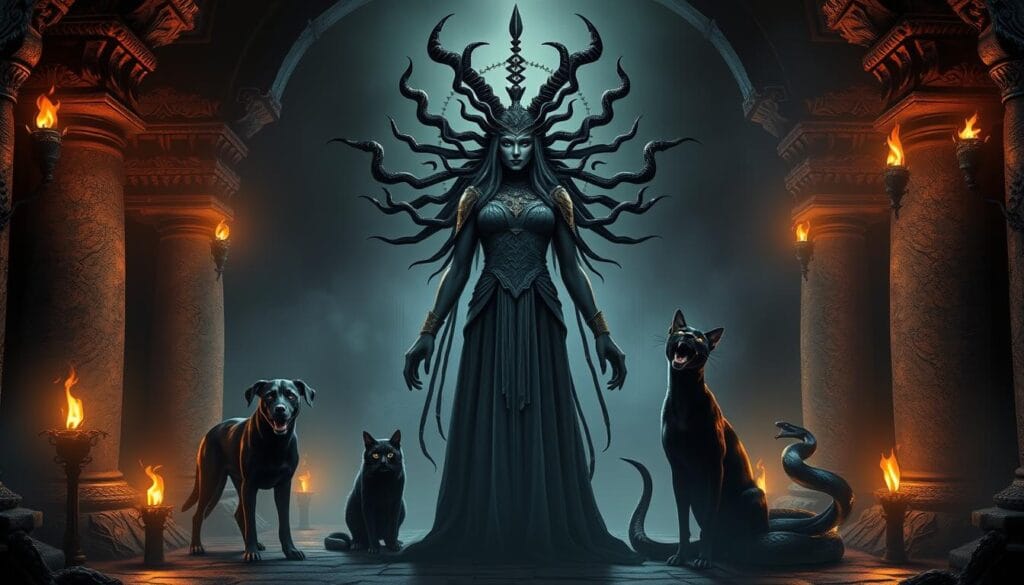
The Importance of Dogs and Snakes
Dogs were the most sacred animals to Hecate. Black dogs were her most devoted followers. The ancient Greeks often sacrificed them to honour the deity in important rituals.
These animals showed many sides of Hecate’s power. They protected homes and travellers. Their sharp senses could spot supernatural beings that humans couldn’t see. This made them great guardians of sacred places and crossroads.
Dogs were also linked to childbirth goddesses. Moon cycles affected their behaviour and human fertility. This connection showed their role in protecting women during childbirth.
Queen Hecuba’s story shows Hecate’s kind side. When the Trojan queen was overcome with grief, Hecate turned her into a black dog. This act brought comfort and allowed Hecuba to serve the deity in a new way.
Snakes later became part of Hecate’s mythology. They symbolised change and rebirth. Their ability to shed skin showed the cycles of life and death that Hecate controlled. The supernatural wisdom of serpents added to her role as a guide between worlds.
Other Animals Associated with Hecate
The polecat, or weasel, was also important to Hecate. This is because of the myth of Galinthias, a clever servant who tricked the gods. When Hera found out during Heracles’ birth, she turned Galinthias into a polecat.
Hecate took pity on Galinthias and welcomed her as a sacred companion. This story shows the deity’s protective side for those who were loyal and clever. The polecat’s cleverness mirrored Hecate’s own wisdom and strategic thinking.
Red mullet fish were also part of some traditions. They lived deep in the sea, connecting them to the mysterious underwater world. Their red colour linked them to blood sacrifices and the supernatural power of transformation.
Owls were sometimes part of Hecate’s mythology, though less often than other animals. These nocturnal hunters represented wisdom and the ability to see in the dark. Their silent flight and sharp calls made them fitting messengers for a deity of night and mystery.
| Animal | Primary Symbolism | Connection to Hecate | Mythological Significance |
|---|---|---|---|
| Black Dogs | Protection and loyalty | Most sacred companions | Queen Hecuba’s transformation |
| Snakes | Transformation and wisdom | Later supernatural depictions | Cycles of death and rebirth |
| Polecats | Cunning and cleverness | Sacred through compassion | Galinthias’ loyal deception |
| Red Mullet | Mystery and depth | Regional deity worship | Underwater realm connections |
These animals show how ancient people saw the natural world as connected to the divine. Each creature brought unique qualities that helped understand Hecate’s complex nature. Their roles in rituals and myths created a rich tapestry of supernatural symbolism that continues to intrigue today.
Hecate's Influence in Literature and Arts
The goddess Hecate has left a lasting mark on literature and art. Her mysterious nature and occult associations have captivated writers for centuries. This is because she represents both wisdom and power.
Ancient poets and playwrights saw Hecate as a unique goddess. They showed her as a bridge between different worlds. Her story began in the 7th century BCE and continues today.
Ancient Greek Tragedies and Classical Literature
Hecate first appeared in Hesiod’s Theogony, where she was given great honour. This text made her a powerful goddess. The Homeric Hymn to Demeter showed her as a kind guide, helping Demeter find Persephone.
Classical tragedians saw Hecate’s dramatic value. In Aeschylus’ Suppliants, she was linked with Artemis. This showed how writers blended divine identities to explore themes.
The Orphic Hymns start with a hymn to Hecate, showing her importance in mystery religions. These texts highlight her spellcraft abilities. Writers like Lucan, Plutarch, and Theocritus further developed her character.
- Hesiod portrayed her as honoured above all other deities
- Homeric hymns established her compassionate nature
- Tragic playwrights used her for dramatic effect
- Orphic traditions celebrated her mystical powers
Modern Depictions in Popular Culture
Today, literature has rediscovered Hecate’s occult heritage. Fantasy novels often feature her as a magical patron. Authors use her ancient spellcraft associations to create engaging characters and stories.
Shakespeare’s influence on English pronunciation of her name shows literature’s impact on culture. Modern horror films often include her in supernatural scenes. TV shows about witchcraft frequently mention her magical and protective sides.
Digital communities have created spaces to discuss Hecate’s relevance. Online forums dedicated to occult studies often analyse her symbolism. Contemporary artists use her imagery in various forms of art.
Music artists have also been inspired by her mystique. Songs about transformation and spellcraft often mention her guidance. This introduces her ancient wisdom to younger audiences.
The goddess continues to inspire creative works across different mediums. Her adaptability allows modern creators to reinterpret her occult associations for today’s audiences. This ongoing artistic evolution keeps her relevant in today’s culture.
Hecate and the Elements
Hecate has always been seen as a goddess of the elements. People long ago believed her power touched every part of the world. She was known for her control over fire, water, earth, and air.
At crossroads, where paths meet, her power was most felt. This was because she could connect different energies and paths.
Zeus gave Hecate control over earth, sea, and sky. This made her very special among the gods. She could talk to spiritual beings in all parts of nature.

Fire, Water, and Their Connection to Hecate
Hecate is often linked with fire, thanks to her torches. These torches light up dark places and guide people through dangerous areas. Fire stands for change, cleaning, and the magic spark in all things.
People thought Hecate’s fire could cleanse negative energies and show hidden truths. Her flames were like beacons for those lost and seeking direction. This fire side of her connected her to spirits in between worlds.
Water is also a big part of Hecate’s story. Zeus gave her power over the sea. She was in charge of rituals that used water to purify and renew.
Her water side is linked to emotional healing and intuition. The ancient Greeks did rituals at crossroads to honour her. These rituals helped people connect with spirits in water.
Earth and Air: Additional Elemental Associations
Hecate is also deeply connected to the earth. She is known as “Chthonia,” showing her role as an underworld goddess. She could find hidden wisdom in the earth and talk to spirits below.
Her power on earth was felt at crossroads where paths meet. These places were like portals for her energy. People would bury offerings there to honour her.
The earth element tied Hecate to practical magic and herbal wisdom. She knew about magical plants and the secrets of caves. Her knowledge was very valuable to those who wanted to make things happen in the real world.
Air connects Hecate to the stars and celestial wisdom. Her power over the night sky linked her to spirits in the air. She could move between different realms through air.
Old texts say she travelled on night winds to reach crossroads. Her ability to move through air made her a bridge between the earthly and divine worlds. This made her a goddess whose influence was everywhere.
Exploring Hecate's Archetypes
Hecate’s archetypes show how this ancient deity goes beyond simple categorisation in Greek mythology. She represents many sides of feminine power at once. This makes her one of the most complex figures in ancient myths.
Her archetypal roles give us a glimpse into how ancient people saw life’s stages and aspects. Hecate shows us how wisdom, protection, and change are all connected.
The Crone: Wisdom and Transformation
Today, Hecate is often seen as the Crone archetype. She’s the wise elder who has learned from life. This archetype is about transformation, death, and rebirth in both the natural and spiritual worlds.
But, ancient stories don’t always match this view. Greek mythology often shows Hecate as a young, beautiful woman. This suggests her wisdom comes from her divine nature, not just age.
Her role in transformation is key, no matter her age. Hecate helps souls through change, teaching them to let go of old things. She shows wisdom comes from facing life’s darker sides and learning from them.
The Mother: Nurturing and Protection
Hecate’s Mother archetype shows her caring and protective side. As a guardian of homes and gates, she kept families safe from harm. She taught them how to protect themselves too.
Even though she’s seen as a virgin, Hecate is linked to birth and child care. Her ties to birth goddesses and the moon show her nurturing side. Ancient followers called her Soteira, the Saviour, showing her maternal care.
This archetype shows motherhood is more than just biology. Hecate guides and protects all who seek her help. She helps them grow and face life’s challenges, nurturing their spiritual growth.
How to Honour Hecate in Your Daily Life
Honouring Hecate in daily life turns everyday moments into chances for spiritual growth. People today find ways to connect with her ancient power while keeping traditional customs. These practices don’t need deep magical knowledge or expensive items.
Building a bond with Hecate is about growing wisdom, courage, and compassion. Her guidance helps us make clear choices at life’s crossroads. Simple, regular practices can build a stronger bond than grand ceremonies.
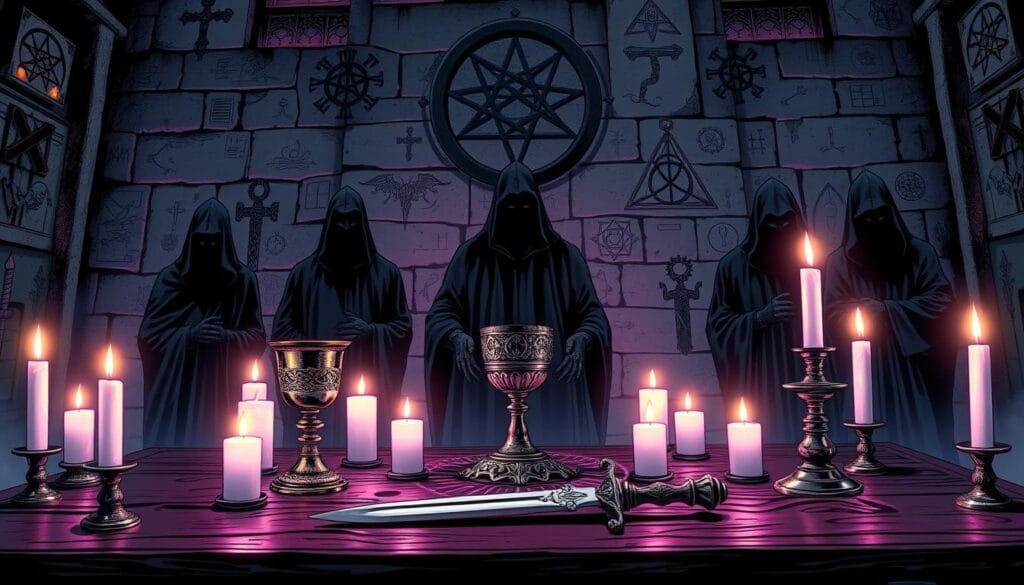
Simple Rituals for Invoking Hecate's Energy
Simple rituals help us honour Hecate without needing to prepare much. New moon offerings are a traditional way. In the past, people left food outside their homes during the new moon, believing Hecate’s power was strongest in darkness.
Today, we can adapt this by leaving small portions of bread, honey, or wine outside. Place it at a crossroads or threshold, showing Hecate’s role as a guardian. Always make sure these practices follow local laws and respect private property.
Lighting candles at sunset is another meaningful ritual. Three candles symbolise Hecate’s triple nature, while one flame honours her underworld connection. The flickering light guides us through dark times and keeps us safe from harm.
Meditation helps deepen our connection with Hecate’s transformative power. Focus on crossroads imagery, seeing yourself receive wisdom at life’s turning points. These sessions are best during twilight, when the veil between worlds is thin.
Protection charms are practical ways to call on Hecate’s supernatural guardianship. Traditional methods include hanging iron keys near doors or making small pouches with protective herbs like rue, mugwort, or vervain. These items remind us of her protective presence.
Creating an Altar for Hecate
Creating a dedicated altar space is a focal point for Hecate worship. Traditional altar items include keys, candles, and images of dogs or serpents. These symbols connect us to ancient traditions while making our altars personal.
The altar’s location is key. Many choose spots near doorways, windows, or other threshold areas. These places reflect Hecate’s role as a guardian of boundaries and guide between worlds. A simple table or shelf works well for most homes.
Essential items on the altar include symbols of Hecate’s key roles. Keys represent her role as keeper of mysteries and guardian of thresholds. Torches or candles symbolise her light-bringing aspect and moon connection. Images of dogs honour her faithful companions and protective nature.
Adding personal touches makes altars more meaningful. Practitioners might include items that represent their spiritual journey or challenges. Photographs, crystals, or meaningful jewellery can strengthen our connection to Hecate’s energy.
| Altar Element | Traditional Significance | Modern Adaptation | Placement Suggestion |
|---|---|---|---|
| Keys | Mysteries and thresholds | Old house keys or decorative keys | Centre or left side |
| Candles | Light in darkness | Black, red, or white candles | Behind other items |
| Dog imagery | Faithful guardianship | Statues, photos, or drawings | Right side or corners |
| Offering bowl | Food and libations | Small ceramic or wooden bowl | Front centre |
Keeping the altar clean and respected is important. Weekly cleaning shows dedication. Fresh offerings during new moons honour traditional customs. Simple prayers or expressions of gratitude strengthen our spiritual bond.
Seasonal decorations reflect Hecate’s connection to natural cycles. Autumn leaves, winter evergreens, or spring flowers can enhance the altar’s energy. These natural elements remind us of her role in life’s continuous transformations.
Remember, creating an altar is deeply personal. While traditional elements provide structure, our personal preferences and circumstances shape each space. The most important thing is to approach the practice with genuine respect and sincere intention.
Conclusion: Embracing Hecate's Wisdom and Magic
The ancient goddess Hecate is as captivating today as she was in the past. She offers timeless wisdom that many find deeply meaningful. Her teachings are a beacon of guidance in life’s toughest moments.
The Ongoing Relevance of Hecate Today
Modern witchcraft and Paganism have made Hecate a key figure. Her protective powers and transformative wisdom are sought after by many. She is a guiding light for those facing big changes in their lives.
Online forums and books are filled with discussions about Hecate. They help us understand how to respect her spiritual power. Her teachings on personal responsibility and power resonate with today’s seekers.
Final Thoughts on Hecate's Influence
Hecate’s true gifts are in building inner strength and compassion. Her teachings encourage us to accept both light and dark. This helps us grow through life’s challenges with wisdom and grace.
Exploring ancient deities like Hecate deepens our understanding of human nature and spiritual growth. Whether through witchcraft or academic study, Hecate’s influence shapes our connection with the natural world and our own growth.
FAQ
Who is Hecate and why is she significant in Greek mythology?
Hecate is a fascinating and mysterious goddess from ancient Greek mythology. She is known as the goddess of magic, crossroads, and the supernatural. Zeus gave her special honours, making her powerful over earth, sea, and sky.
Unlike many Greek gods, Hecate’s influence spanned multiple realms. This made her important to ordinary people who worshipped her at home and crossroads.
What are Hecate’s main symbols and what do they represent?
Hecate’s symbols include torches, keys, daggers, and serpents. Her torches guide us through darkness and reveal hidden truths. Keys show her role as guardian of mysteries and thresholds.
Her triple form represents her power over past, present, and future. Her lunar connections symbolise transformation and liminal spaces.
How did ancient Greeks worship Hecate in their daily lives?
Ancient Greeks worshipped Hecate through household shrines and crossroads offerings. They left food at crossroads during the new moon, believing she would consume it with restless spirits.
Many families kept shrines to her for protection. Women honoured her during childbirth, and those seeking guidance during life transitions did too.
What is Hecate’s connection to witchcraft and magical practices?
Hecate has been linked to magic and spellcraft for ages. She was a teacher and protector of those who practised magic. Famous figures like Circe and Medea were connected to her.
Ancient practitioners saw magic as a natural force for protection or healing. Hecate guided them in herbal magic and protective rituals. Today, Wiccan and pagan traditions see her as a patron of witchcraft.
Why is Hecate called a psychopomp and guide of souls?
Hecate is a psychopomp, guiding souls between the living and the dead. Her role comes from her association with crossroads and her ability to traverse realms. She helped Demeter find Persephone, showing her compassionate nature.
She assists both the living in major life transitions and souls on their journey to the underworld.
What animals are sacred to Hecate and why?
Dogs are sacred to Hecate, representing loyalty, protection, and supernatural sensing. Ancient Greeks believed dogs could detect her presence. Sacrifices were made at her festivals.
Other animals include serpents (transformation and wisdom), polecats (cunning and adaptability), and creatures of the night.
How has Hecate been portrayed in literature and popular culture?
Hecate appears in classical literature, like the Homeric Hymn to Demeter, and in modern media. She’s seen as a protector and a goddess of the night. Modern creators have reimagined her, focusing on her witchcraft and guidance.
What is Hecate’s connection to the classical elements?
Hecate is connected to all four classical elements. Fire is represented by her torches, symbolising transformation. Her water associations come from her sea connections and cleansing rituals.
Earth connects to her chthonic nature and hidden wisdom. Air links to her starry heavens and realm movement, showing her power in all existence.
What archetypes does Hecate represent?
Hecate represents the Crone archetype, with wisdom and transformation. Yet, she’s also seen as youthful and beautiful, showing wisdom isn’t age-bound. She embodies the Mother archetype, nurturing and protecting.
Her multifaceted nature makes her relevant to people at different life stages.
How can someone honour Hecate in modern times?
Honour Hecate with simple practices like lighting candles at crossroads and creating protective charms. Observe lunar cycles and set up altars with keys, candles, and images of dogs. Offer food or flowers during the new moon.
These actions respect her traditions while being accessible to today’s spiritual seekers.
What festivals were dedicated to Hecate in ancient times?
Ancient Greeks celebrated Hecate with festivals and rituals, including monthly Deipnon offerings at crossroads. She was important in mystery religions at Samothrace and Eleusis. Her worship was intimate, happening in homes and crossroads.
Dogs played a big role in her ceremonies, and seasonal observances marked important transitions.
Why does Hecate remain relevant in contemporary spiritual practices?
Hecate remains relevant today because her ancient roles of protector, guide, and teacher of wisdom are timeless. She’s important for those navigating life transitions, seeking empowerment, or exploring their spiritual path. Her message of transformation and personal responsibility resonates with modern seekers.
